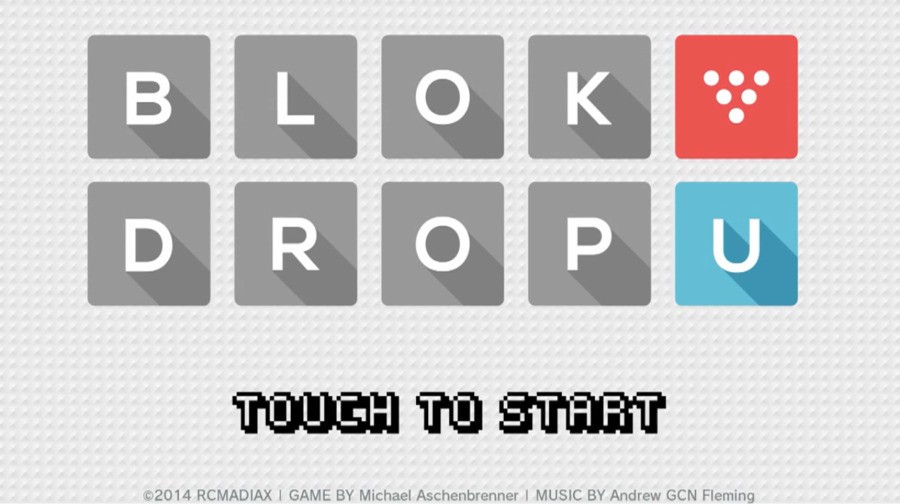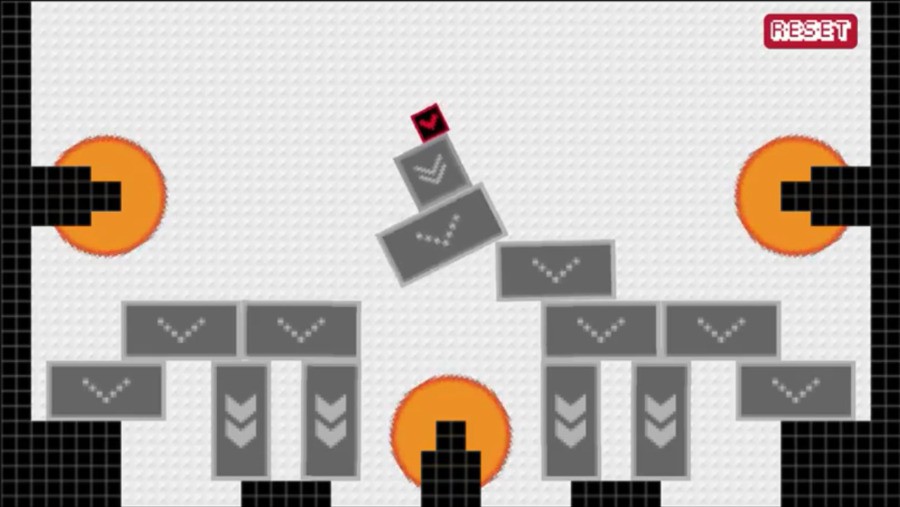
Throughout 2013 Nintendo went to a good deal of effort to spread the work that its platforms, particularly the Wii U, were supportive of small, download-only developers. Much focus and, by extension, confirmed releases fell into the Unity engine camp, with Nintendo offering free tools and usage of the widely-used development engine on the platform. The Nintendo Web Framework, however, intrigued in theory but has had far less attention due to the absence of visible projects utilising the service.
That may start to gradually change in 2014, with an early trailblazer being BLOK DROP U, which is currently awaiting approval for release in North America. It's a simple concept both visually and in terms of gameplay, which will come at a budget price with free updates down the road. With the Web Framework opening the doors of the Wii U eShop further, this title could be the first of a steady stream of these sorts of experiences.
Keen to learn more ahead of release, we've caught up with Michael Aschenbrenner, the one-man-band that is RCMADIAX Games.

Nintendo Life: First of all, can you introduce yourself and tell us more about RCMADIAX Games?
Michael Aschenbrenner: Yes, my name is Michael Aschenbrenner. I was born and raised in Pittsburgh, PA, which I currently reside. By day, I am a Field Sales Representative, and by night a hobby indie game developer. RCMADIAX was formed late last year and consists only of myself.
NL: How long have you been developing games? Can you give us some background on when you started to learn coding and your early steps up to this point?
MA: I have always been working on games as a hobby and never really took it as a serious career move until recently. When I was very young in the early days of the internet, HTML was the first programming language I knew. My only other attempt at releasing a game came in 2012 when I hired a programmer to make an iOS game for me. It was a horrible experience to say the least and turned me off to developing for some time.
NL: Can you explain the inspiration and influences behind BLOK DROP U?
MA: When HTML5 gaming started to take off, I came across some tutorials that featured real-time physics by removing objects below and letting the upper objects fall into place on the ground. I was obsessed with this idea and ran with it. Let's face it, we all at one point built a huge skyscraper with LEGOs and then watched it fall to the ground as we destroy it. It's a lot of fun!
NL: At what point did you decide to release the game on Wii U? Can you also clarify whether it will be exclusive to the system?
MA: It was almost right after finding that demo at GDC 2013 (Game Developers Conference) that took place and Nintendo showed off the Web Framework. Yes, it will be exclusive to Wii U.
NL: Our early time with the game has brought home a tough level of difficulty; are you keen to challenge players with this title?
MA: I knew from the get go that I wanted it to be a challenging game. The biggest obstacle I have faced would be judging which stages are harder than others. What I consider difficult might be easy for someone else and vice versa. I will closely monitor Miiverse upon release and may switch around the order of the stages in a future patch depending on feedback.
I would be lying if I said that my pricing and update strategy wasn't influenced by smart devices.
NL: Can you outline how the GamePad is used in this game, and explain whether it influenced your initial design in the project's early days?
MA: The GamePad's touch screen is the main and only way of input. It's such a natural way of playing this game, simply tap the "blok" you want to remove. The GamePad controller had no real influence over the design of the game, but instead influenced which platform it would launch on.
NL: So no other control schemes supported, alternatives to the touch controls?
MA: I had some early demos running with the Wii Remote as a supported controller. The problem I ran into was that some stages require you tap the "bloks" in a rapid order. To me, using the pointer didn't make this practical and just added frustration to the game. Although I am open to adding the feature back in if the consumer requests it.
NL: Can you outline the release strategy for this, in terms of a rough price band and plans for additional content down the line?
MA: Plan is to release in Q1 of 2014 for the North American markets at $1.99. The project has been submitted to NoA for review as of this writing. I am also working on a release for Europe and Australia, but that may not hit the Q1 timeframe and instead slip into Q2. No plans to launch in Japan, unless there is a publisher that would like to bring it to that market! I do have plans to add in 20 FREE new stages in Q2/Q3 2014, with a final batch of 30 FREE additional stages in Q4 2014. Bringing the total number of stages in the game to 80 with no increase in price.
NL: Is your release model inspired by smart device games — with regular free content updates — and is this something you expect to see more of on the Wii U eShop?
MA: I would be lying if I said that my pricing and update strategy wasn't influenced by smart devices. I certainly see a market for lower priced or even Free 2 Play games on the eShop.
NL: We understand this game is HTML5-based, so can you explain this for readers unfamiliar with the term?
MA: Basically it is a web-based programming language. The same type of code that generates websites can now be used for interactive entertainment.
NL: So this game utilises the Nintendo Web Framework, which was regularly presented at developer conferences last year. Can you explain how that framework operates?
MA: Yes it does. Nintendo Web Framework works by turning HTML5, Javascript, and CSS3 into a native Wii U application.

NL: How important are Wii U-specific tools or documentation in your project, or is it more a case of standard HTML5 code simply being bolted onto the system?
MA: Of course none of this would be possible without tools and documentation from Nintendo. Most of the code is natural HTML5, but there are situations when hardware or services must be called into your project that requires specific Nintendo API's (application programming interfaces).
NL: When did you first get in touch with Nintendo, and how easy or complicated was that process?
MA: I applied for the program the moment the inquiry site went live during GDC 2013. The questionnaire is very straight forward and I encourage anyone looking to develop games to give it a try.
NL: Does working in HTML5 and the Web Framework throw up any limitations in comparison to custom engines or pre-built tools such as Unity?
MA: The only limitation is your imagination! I can't speak of Unity, as I didn't try that engine yet, but I haven't had any issues with my tools working with the framework.
NL: In general, has this development on Wii U been easier or more challenging than anticipated, or about on par with expectations?
MA: It has actually been easier than I anticipated. Everyone at Nintendo has been more than forthcoming with giving their help and support. I never experienced delayed communication problems that some of the recent "anonymous" developers have. Very pleased and, depending on sales of BLOK DROP U, all my projects may be Wii U exclusives.
NL: Do you anticipate more games in the style of Block Drop U in future, utilising HTML5 and relatively simple, clear designs?
MA: At first I do, as many are getting familiar with the tools and their skill set. As time goes on you will see more robust projects, not just from me, but other developers as well.
NL: Do you currently have any plans to develop games for the 3DS?
MA: Since I only have experience with HTML5 programming at this point, I don't have any plans to develop on 3DS. Unless of course they bring the framework to 3DS!
NL: What would you like to say to Wii U owners unsure of BLOK DROP U, those on the fence?
MA: Give it a try! It's a game that even if you don't like it, more than likely your family and friends will. I designed it to appeal to a large audience of gamers and non-gamers alike. It takes very little space on your Wii U, and at $1.99, that's about the cost of a pack of gum! Support the Indies!
We'd like to thank Michael Aschenbrenner for his time.





Comments 21
Looks fun. I might give it a try!
I'll be picking this up for sure, my comics cost more than that and I love the concept/challenge.
Looks like a game my boys will have a lot of fun with.....at $1.99 I may grab it and give him some support.
i chatted a tiny bit with him on miiverse. quit a nice fellow
$2? Free DLC? I'll give it a shot!
There is no doubt this game is fun, I might give it a try.
Just like RUSH and EDGE, at that price there's no reason NOT to buy.
This is the kind of developer you absolutely have to support. A Pioneer of a new development system that is a potential gold mine of new and unique Content. $2.00 is a steal for just about any game and a small price to pay for Solid Indie Support. I can already tell, despite it's visual simplicity, this is going to be one of those games that makes me want to throw my gamepad.
Soon I'm going to be a game developer to make small indie games for Wii U like him.
Well this is nice to hear. I hope he gets decent sales.
I will buy it. My kids and myself love these kinds of games, and he is definitely the kind of developer we need to support. The price is cheaper than a beer, and I need to drink less, so I will spend my beer money on games instead.
It's nice to have this kind of insight when you're getting into HTML-based game development, like myself. Reading this reassured me to go for it!
I'll be getting this. 2 bucks is a steal.
It looks like fun, but I wish he'd do something to make the graphics better — maybe just a little splash of colour. I can't see myself staring at that for hours.
Looks like a variation of Angry Birds
The more people buy this the better his next game will be.
This looks like it could be ridiculously hard...and I love it! On a side, it always that simplest concept create the hardest challenges.
Might just buy it for the great value. Having a bunch of free DLC is really nice.
I'm definitely buying this. My kids and I love puzzle games like this.
Just like RUSH and EDGE, at that price there's no reason NOT to buy.
Are BigDog and WiiLovePeace the same person? Bit weird that it's the exact same comment...
Tap here to load 21 comments
Leave A Comment
Hold on there, you need to login to post a comment...